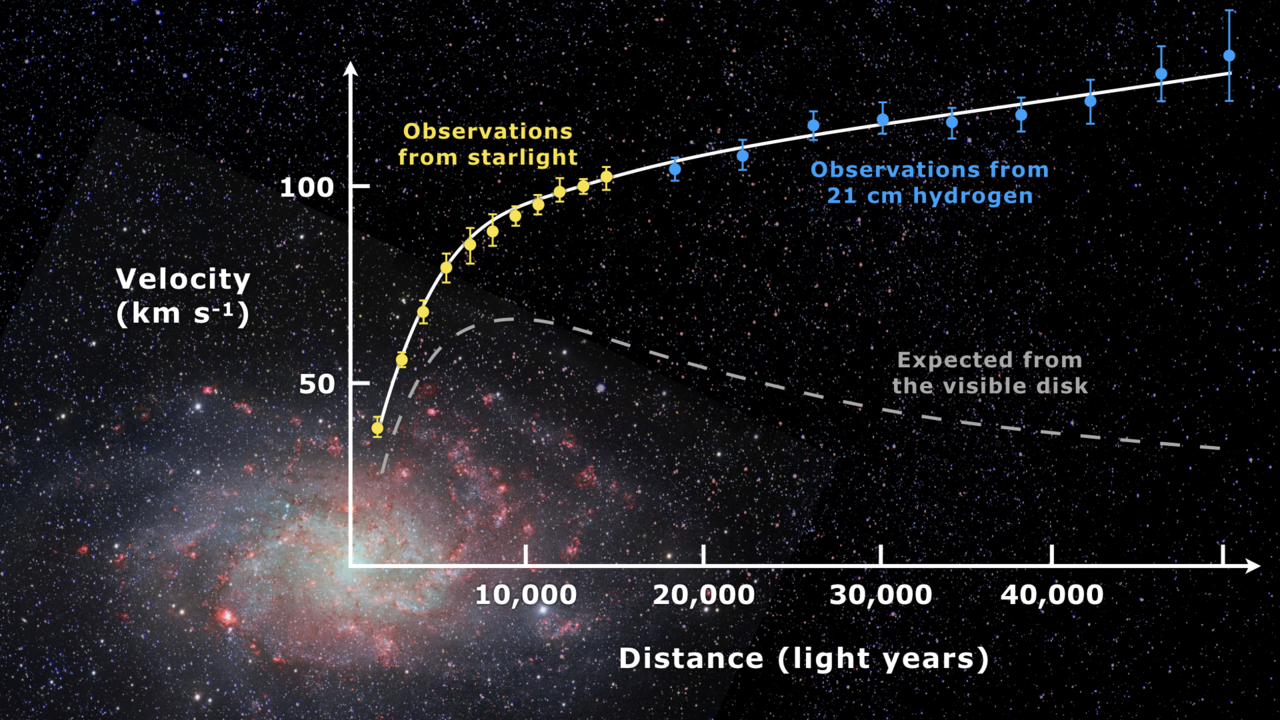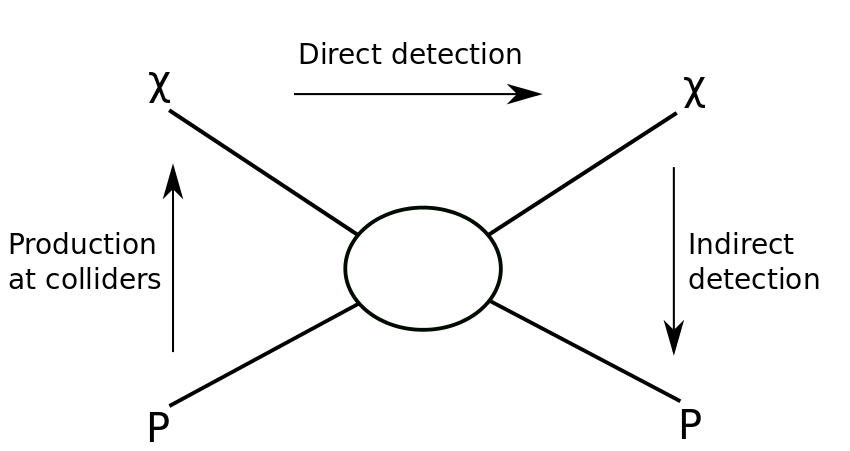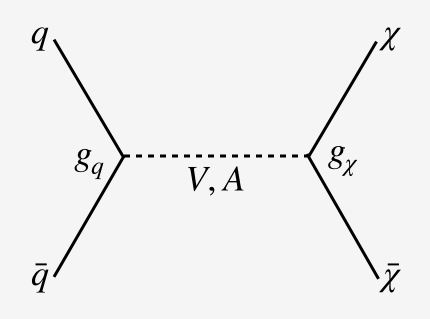Dark Matter Theory Basics
Overview
Teaching: 10 min
Exercises: 0 minQuestions
What do we actually know about DM?
What are the main ways we investigate the particle nature of DM?
Objectives
Understand where we at the LHC fit into the broader DM context.
Get an introduction to the LHC Dark Matter Working Group.
More than a quarter of the energy density of our Universe consists of Dark Matter (DM). We know DM has gravitational interactions, hence the name “matter”, and it is not visible like stars in a galaxy, hence the name “dark”. Our only observations of DM so far comes from its gravitational interactions, \emph{eg} providing extra gravitational force in a galaxy such that the stars away from the galactic center rotate faster than expected from only visible matter.

Go Read for Yourself
This introduction is far too brief but one of the most comprehensive reviews is from 2004 - hep-ph/0404175. The fact that it is from 2004 and still is entirely relevant 15 years later gives you a strong sense of where our understanding as a community is concerning DM. Although we are probing more broadly and deeper with all experiments, the fundamentals remain unchanged.
There are theoretical motivations to believe that DM is a new (elementary or composite) particle and interacts with the SM, albeit weakly. DM could be a Dirac or Majorana fermion or a scalar particle. It can have various types of interactions with the SM, for example through the exchange of new massive gauge bosons. The conventional wisdom has been that DM relic density is set by its annihilation into SM particles via weak-scale interactions. These type of DM models are generically called WIMPs, for Weakly Interacting Massive Particles, and have served as the paradigm for DM searches at the LHC since Run 1.
The Three-fold Way
There are three main ways to detect possible DM interactions with SM particles.
- [1] - Direct Detection : DM can scatter off of SM particles. We expect to see these scattering processes “directly” when they recoil from samples of material that are placedin very controlled, low-background environments. Experiments such as these are LUX or Xenon-1T.
- [2] - Indirect Detection : In environments like the center of the galaxy, where the density of DM is high, DM particles can annihilate to SM particles. Astrophysical observations could detect the SM particles (e.g. photons or positrons) produced by DM. This is called “indirect detection” because we only observe the final products and not the DM itself. Two very well-known indirect detection experiments are Fermi LAT and AMS.
- [3] - Production/Collider : The final means by which we probe DM is through its production at colliders. If you have already accepted [1] then you should be comfortable enough to simply reverse the process and cross your fingers that when we collide SM particles, some amount of the time we will “produce” DM, hence the nomenclature “production”. At the moment, the biggest players in the game at the LHC are ATLAS and CMS, but B-factories like Belle-II will provide very complementary perspectives.

Our “Benchmark” Model
The DM model we will focus on contains Dirac fermion DM particles coupled to the SM via a gauge mediator. The mediator can be either a vector or an axial vector, as in the weak interactions of the SM. This simplified model has 4(-ish) parameters
- Mediator mass : m(V)
- Dark matter mass : m(DM)
- Coupling between DM and the mediator : g(DM)
- Coupling between DM and the mediator : g(SM) - this is where the “-ish” gets introduced and where you can first become most acutely aware of the rather extreme model dependence of the statements. There are many SM particles that the mediator can possibly couple to (e.g. quarks vs. leptons) and though we often boil this down into one coupling constant, you must be aware of the assumptions this implies.

At the LHC, if produced, DM would contribute to the missing transverse energy (Ahhhhh, but don’t call it energy if you are a hardcore experimentalist … more later.) because it does not decay and is does not interact with the detectors. Well, at least, when the reconstruction is performed we assume that it does not … which is a good assumption given that people spend their whole lives looking for a single interaction in a specially designed detector with low noise (i.e. direct detection). Therefore, one experimental handle the we can use to be sensitive to something we can’t see is to consider signatures with a radiated gluon from the initial state, which will form a hadronic jet. These are called monojet searches. They are not new and have been performed since LEP and SPS but they are so “bread and butter” for a DM enthusiast that they are what we will focus on in this tutorial. (Don’t worry, much more on how one of these is done will come later.)
The LHC Dark Matter Working Group
In this tutorial, we will be presenting a very biased perspective, focusing on the “Production/Collider” side of things, particularly that of the LHC. To give you some of the history of how we view this at the LHC, there is a dedicated working group called the LHC-Dark Matter Working Group that provides a context to ensure broad coverage of both theorists and experimentalists interested in this topic. If you are not on the mailing list, feel free to join! And it is thanks to this group which organized a comprehensive study during the first long shutdown of the LHC (1507.00966) that aimed to standardize the models that are probed. This helped to simplify the discussions and ensure that we were all talking the same language, which is that of “simplified models”. These are models which we admit are probably too simple for nature to realize “in reality”, but give us a concrete forum by which to benchmark the sensitivity of our searches and identify and “holes” in our coverage. One of the initial outcomes of this work was precisely the vector-mediator and axial-vector-mediator models discussed above, which have served as one of the primary benchmarks since the beginning of Run 2.
After becoming comfortable with this, the same group set about to solidify more concretely just how these results can and should be presented. The reasoning here is that since there are three broad communities of physicists probing DM, and the probes at the LHC are some of the most model specific, how can we present our results with a clean conscience. This resulted in a very nice work (1603.04156) that clarifies the relevance of things like “How seriously should I take that ‘relic abundance’ exclusion?”. At the same time, a considerable effort was sunk into improving our understanding of the dominant SM backgrounds to these searches as well as the associated uncertainties on these backgrounds, resulting in precision recommendations for V+jets predictions (1705.04664).
However, with a lack of clear evidence for a positive signal of DM at the LHC from the beginning of Run 2, the next step was to understand if this is because we weren’t “looking in the right places”. This lead us from the simple (axial-)vector-mediator model to the “2HDM+a model” (1810.09420) which introduces a few new particles and couplings and therefore opens up the possibility for more exotic signatures. Perhaps the ability to produce DM via SM couplings is being muddied by looking at signal regions that are too “inclusive”, perhaps we must focus on a specific corner of phase space to see the signal pop up.
Finally, and most recently, this group has begun to focus on what are called “t-channel models” in which there is no resonant s-channel degree of freedom as before, but there are couplings that cause for transitions from SM to DM via a mediator emission. This is ongoing work within the group and with the tools that you learn in this workshop, you will already be in a place to contribute! COOL!
SUSY has DM
Although it may seem so obvious to some, it should not go without saying that supersymmetry has always provided a means by which to describe DM in the form of the “lightest supersymmetric particles” (LSP). This is nothing new and the LHC experiments have dedicated groups searching for SUSY. However, you may sometimes find that the focus at this workshop will trend in the direction of simplified models or “generic signatures”. But don’t forget SUSY … “it’s just around the corner!
Key Points
All we know about DM is that it interacts gravitionally … therefore ‘matter’.
DM does not seem to interact with anything else, particularly light … therefore ‘dark’.
DM is not necessarily a particle, but we work under this assumption much of time time.